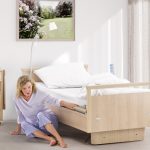Not only people in need of care who have to stay in bed depend on an ergonomically high-quality and comfortable bed, but professional caregivers also benefit from well-designed beds that are easy on the back and save time.
Even healthy people spend about a third of their lives in bed, sick people much more. Reason enough for a comfortable bed that provides an optimal position, relief and relaxation not only during sleep but also during the day. A nursing bed must therefore always be adapted to the special needs of the person being cared for and the working conditions of the caregivers.
Around the nursing bed
In today’s world, where modern low beds have already found their way in, it is hard to imagine that it was only around the turn of the century 1800/1900, in the course of medical progress, that the simple wooden beds gave way to more comfortable adjustable beds, which were more and more adapted to individual and hygienic needs and, in the course of time, equipped with hydraulics. In the meantime, hospital and nursing beds are subject to certain standards and regulations and meet the highest medical, hygienic and nursing requirements. They have functions such as individually controllable segments of the slatted frame, swivel and rotate functions, height adjustability for fall and protection prophylaxis, mobilization and stand-up aids, which generally facilitate positioning measures and the work of professional caregivers and positively influence the quality of life of people in need of care.
For example, low nursing beds (like sentida 5/6) with a 3-stop strategy now offers not only safe fall prevention during sleep, but also ideal mobilization and a back-friendly care position. For this purpose, the bed height can be adjusted at the touch of a button from 27 cm floor height (sleep) with automatic intermediate stop at predefined chair height of 41 cm for mobilization to 80 cm for nursing activities. Using the hand control, nursing staff can also quickly set pre-programmed positioning positions for comfort seating and decubitus prophylaxis. The ergonomic BiNetik lying surface optimizes pressure ulcer prevention. Thanks to the double retraction, the lying surface can be increased by up to 17 cm and, with the additional 6 cm leg rest retraction, goes far beyond a simple back rest retraction. The BiNetik system thus provides noticeable pressure relief in the lumbar and pelvic areas.


